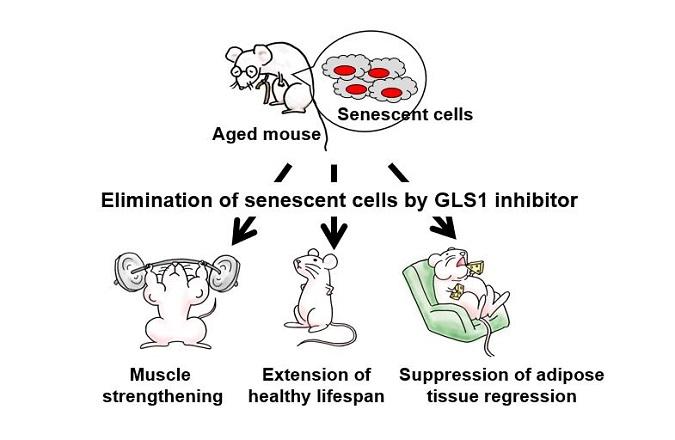
Credit: ©NAKANISHI Makoto, The Institute of Medical Science, The University of Tokyo(IMSUT)
Senescent cells accumulate in organs during aging, promote tissue dysfunction, and cause numerous aging-related diseases like cancer. The cells arise through a process called “cellular senescence,” a permanent cell cycle arrest resulting from multiple stresses.
A collaborative research group led by Professor Makoto Nakanishi of the Institute of Medical Science, The University of Tokyo (IMSUT), and co-researchers has identified an inhibitor of the glutamate metabolic enzyme GLS1(*1) so that its administration selectively eliminates senescent cells in vivo. They confirmed that the GLS1 inhibitor eliminated senescent cells from various organs and tissues in aged mice, ameliorating age-associated tissue dysfunction and the symptoms of obese diabetes, arteriosclerosis, and NASH. The results of this research were published in “Science” on January 15, 2021.
Previous studies have shown that genetically engineering removal of senescent cells from aged mice delays the onset of geriatric diseases such as arteriosclerosis and renal damage and extends the healthy life expectancy. However, those studies have not led to identifying useful drug candidates.
Professor Nakanishi said,” Our results can contribute to the development of new anti-aging therapies that remove senescent cells by targeting these cells’ metabolic characteristics.”.
Lysosomal membranes hold the key to senescent cell removal
The research team has developed a new method for producing purified senescent cells to search for genes essential for senescent cells’ survival. This new method activates the p53 gene in the G2 phase, which can efficiently induce cellular senescence.
They used purified senescent cells to search for genes essential for senescent cells’ survival, then identified GLS1, which is involved in glutamine metabolism, as a potential candidate gene.
When they examined the effect of GLS1 inhibitor on the mortality of senescent cells, senescent cells were more sensitive to GLS1 inhibition due to damage to the lysosomal membrane and decreased intracellular pH. When they administered GLS1 inhibitors to aged mice, senescent cells in various tissues and organs were removed, and the aging phenomenon was significantly improved.
Organelles called lysosomes(*2) play an essential role in the regulation of intracellular pH. The team analyzed the dynamics of lysosomes and found the vital fact that damage to the lysosomal membranes in senescent cells lowers intracellular pH.
For details of the research, please see the paper.
Expectations for innovative anti-aging therapies and treatments for geriatric diseases
The results of this study show more interesting results. As aging progresses, motor function declines due to muscle loss, and metabolic disorders due to adipose tissue atrophy occur. But, when the research team injected GLS1 inhibitors into mice suffering age-related disorders, the progression of these age-related symptoms was suppressed. Moreover, GLS1 inhibitors were able to relieve the symptoms of obese diabetes, arteriosclerosis, and NASH(*3).
According to the team, GLS1 inhibitors are currently in clinical trials as effective cancer treatments. “We hope that innovative anti-aging therapies and treatments for geriatric diseases will be developed that can remove senescent cells by treatment with GLS1 inhibitors,” said Professor Nakanishi.
###
Co-researches
Keiichi Nakayama (Professor, Department of Molecular and Cellular Biology, Medical Institute of Bioregulation, Kyushu University)
Masaki Matsumoto (Professor?Department of Omics and Systems Biology?Niigata University)
Makoto Suematsu (Professor, Department of Biochemistry, Keio University School of Medicine)
Yuki Sugiura (Assistant Professor, Department of Biochemistry, Keio University School of Medicine)
Makoto Arita (Team leader, Laboratory for Metabolomics, RIKEN Center for Integrative Medical Sciences)
Masataka Sugimoto (Director, Research Institute, National Center for Geriatrics and Gerontology)
Research Notes
(*1) GLS1
Abbreviation for glutaminase 1. A type of amidohydrolase enzyme that produces glutamic acid and ammonia from glutamine.
(*2) Lysosomes
One of the membrane-enclosed organelles of eukaryotes. The lumen of lysosomes is acidified to around pH 5 and contains hydrolases, allowing the organelle to perform intracellular digestion.
(*3) NASH
A disease in which fat accumulates in the liver in an alcohol-independent manner, causing inflammation and fibrosis. As it progresses, it causes cirrhosis and liver cancer.
Media Contact
Professor Makoto Nakanishi
[email protected]
Original Source
https:/
Related Journal Article
http://dx.



